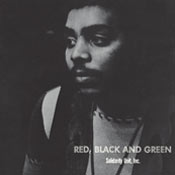Home » Jazz Articles » Extended Analysis » Solidarity Unit, Inc.: Solidarity Unit, Inc.: Red Black & Green
Solidarity Unit, Inc.: Solidarity Unit, Inc.: Red Black & Green
 Solidarity Unit, Inc.
Solidarity Unit, Inc. Red Black & Green
Eremite
2009
Though it certainly had an impact on the landscape of creative music in the 1970s and 1980s as well as it does today, the vanguard improvisation scene in St. Louis isn't as discussed as it should be. The Black Artists Group was analogous to Chicago's AACM (Association for the Advancement of Creative Musicians), and focused as much on happenings and intermediary arts as it did presenting concerts and recordings of improvised music. Though figures like saxophonists Oliver Lake, Julius Hemphill and Hamiet Bluiett were BAG members (in addition to AACM trumpeter Lester Bowie's brothers, trombonist Joseph and saxophonist Byron), cornerstone BAG recordings are extremely scarce and all have been out of print for many years. Most of the records were released privately, on labels like Universal Justice, Oliver Lake's Africa Publishing, and BAG Records. By the middle 1970s, the collective had pretty much folded, and like the AACM many of its members relocated to New York.
Solidarity Unit, Inc. was just one of the bands led by drummer Charles "Bobo" Shaw, featuring among others Joseph Bowie, Lake, trumpeters Baikida Yaseen (later Carroll) and Floyd LeFlore, bassists Carl Richardson and Kada Kayan, and guitarist Richard Martin (Defunkt). Red Black & Green, recorded in 1970 in homage to Jimi Hendrix on the day of his death, features the band on two of Shaw's pieces and LeFlore's "Floreo." If you were to compare the AACM and BAG aesthetics on the basis of a single title, BAG music would come off as being significantly rougher and more unhinged. Though the use of "little instruments" like flutes, harmonica, bells and noisemakers is prevalent, there's a sense of raw urgency in the proceedings, a combination of urban squalor blues and an attitude reminiscent of Lester Bowie's "good old country ass-kicking" (George Lewis, A Power Stronger than Itself, p. 370).
"Something to Play On" is mostly a feature for Martin's rumbling, feedback-drenched bluesy skree, an Afro-American counterpart to players like Ray Russell and Masayuki Takayanagi. A simple upswing theme and loose 4/4 gives way to Lake's bubbly fire-spitting, Joseph Bowie's metallic slush and blustery vocalizations guiding overdriven collective din. But it's Martin who steals the show, skittering spikes and bundles of notes soon buried in stomach-churning feedback and gritty, high-pitched wah-wah. There's an odd tension struck between upper-end notes and floor-shaking low end, a distorted and grungy bottom that exacerbates the fuzzy din of in-the-red group playing.
Recording quality—or lack of it—lends an interesting vibe to the proceedings, the ensemble often outpacing the levels and causing the music to achieve a textural density that is nothing less than electric. The short piece "Floreo" is a burst of energy that likewise is buried in condensed sonic wash, occasional flourishes of electric piano, conga and tambourines bubbling out from the din. The other side of the coin is, of course, that something is lost in clarity—the angularity of LeFlore's theme and detail in the group improvisations remains buried in lo-fi squall. Reel Recordings' Mike King remastered the music, but not in a way that removes any of the session's DIY sweat.
Contrary to the first side's unruliness, "Beyond the New Horizon" finds a rolling groove at the outset, Lake and Bowie spanning centuries with birdsong flute and red-light tailgate in staggering, urgent front-line interplay. As an early recording of Oliver Lake, Red Black & Green stands very high—he's loquacious and unfettered here, yet his flights always retain consistent detail and groundedness. He's taken the language of John Coltrane's soprano playing and parsed it into a more "micro" approach, and placed next to Bowie's noisy chortle and split-toned exhortations, it covers a wide range of instrumental ground. Though this isn't your average "free bop" record, Shaw's percussion arsenal is full of dry snare crack and in free time, he subdivides his phrases into fragments that can easily be reassembled into light bebop swing. One can hear strong echoes of Roy Haynes in his playing, skittering brightness with an implied metronome suddenly (and often) upturned into angular sonic blocks.
Having the music of the Solidarity Unit back in circulation is a coup for followers of free jazz as it developed in the States, for this is a raw and far-reaching set that provides an excellent window into the activities of the Black Artists Group. Hopefully more of the BAG's sparse catalog will find its way back into circulation.
Tracks: Something To Play On; Floreo; Beyond The New Horizon.
Personnel: Charles "Bobo" Shaw: drums; Oliver Lake: alto and soprano saxophones, flute; Joseph Bowie: trombone; Floyd LeFlore: trumpet; Baikida Yaseen: trumpet; Clovis Bordeaux: electric piano; Richard Martin: guitar; Kada Kayan: bass; Carl Richardson: bass; Danny Trice: conga.
Personnel
Album information
Title: Solidarity Unit, Inc.: Red Black & Green | Year Released: 2009
< Previous
Prologue
Next >
Filmworks XXIII: El General
Comments
Tags
For the Love of Jazz
 All About Jazz has been a pillar of jazz since 1995, championing it as an art form and, more importantly, supporting the musicians who create it. Our enduring commitment has made "AAJ" one of the most culturally important websites of its kind, read by hundreds of thousands of fans, musicians and industry figures every month.
All About Jazz has been a pillar of jazz since 1995, championing it as an art form and, more importantly, supporting the musicians who create it. Our enduring commitment has made "AAJ" one of the most culturally important websites of its kind, read by hundreds of thousands of fans, musicians and industry figures every month.

















